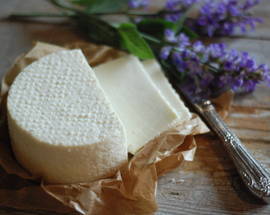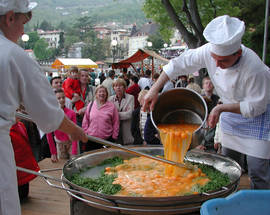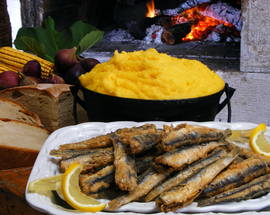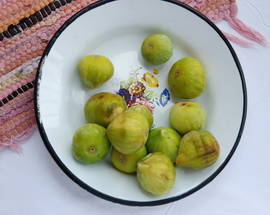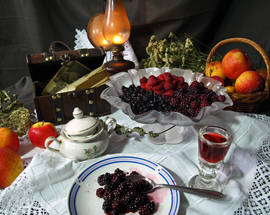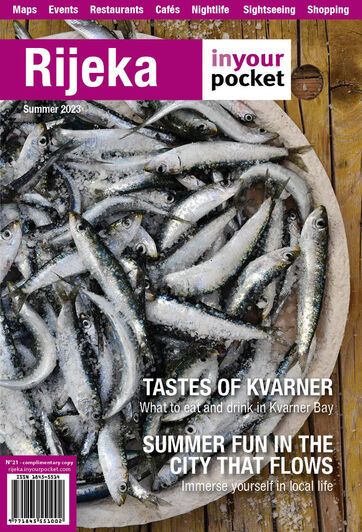Jump to:
Local Dishes
Rijeka’s enviable location where mountains meet sea, where islands meet the rural delights of the Istrian peninsula, allows you to enjoy a great variety of foods, from fish and seafood to meat and game, by way of tender young garden vegetables and scented Mediterranean herbs. You can read more about the benefits of the Mediterranean diet in our Health Tourism section, here we’ll focus on the gastronomy of the region.Let’s start with the islands. The islands of the Kvarner region, especially Cres and Pag, are known in Croatia for excellent lamb, cheeses and medicinal herbs. The first two are dependent on the latter. It is said that the fine flavour of the island lamb is thanks comes from the animals’ pasture on the island hillsides, herbs laced with salt from the wind. Cres and Pag have a number of great eateries where you can enjoy locally-reared lamb – see our Restaurants section. Bear in mind that lamb is naturally at its best in the springtime.
This environment is also the reason why the islanders produce excellent sheep’s milk cheese. Pag island in particular has a long tradition of producing cheese and there are a few good larger manufacturers on the island. A notable one is Gligora – you can call into their factory at Kolan in the central part of the island and taste some of their products.
As well as being a favourite foodstuff of sheep and goats, the benefits of herbs for humans are well-known. One of our favourite things about Croatia’s coast is how lush its vegetation is, and the air is redolent of herbs and pine. For this reason, ever since the 19th century people have been sent on doctor’s orders to the Kvarner coast to recover from illness and allergies. You can buy the distilled benefits of wild herbs in the form of essential oils, balms and strong spirits which have deep roots in folk medicine. Myrtle, bay, strawberry tree, sage and lavender... You can find out more about these herbs by visiting the Garden of Fine Scents at Mali Lošinj town (Ulica Braće Vidulića 68).
Still on the islands, we can’t talk about Kvarner cuisine without mentioning šurlice, a speciality from the island of Krk which you’ll find throughout the region. This is a type of pasta made by wrapping the dough around a knitting needle. Hand-made pasta with a rich sauce is always a pleasure, and there are many different sauces to choose from, though we’d say goulash is probably a classic.
On the island of Rab, you’ll probably spot rapska torta (Rab cake). This is a centuries-old recipe that was a favourite of wealthy families during the Venetian Republic. Often shaped like a spiral, a marzipan-like mix of almonds, eggs, lemon and orange peel and Maraschino liqueur is encased in delicate pastry. It’s usually baked at weddings and other celebrations, and since it keeps for about two months it’s sold beautifully-packed as a souvenir.
Most island villages in the summer months have festivals during which you can sample local delicacies and enjoy music and dancing with the locals. This is a great opportunity to find out more about the local culture, so we definitely recommend you check the festivals out.
In the springtime, a brilliant treat is asparagus picked in the wild. Wild asparagus is slimmer than the cultivated variety and has a stronger, slightly bitter taste. It’s great in risottos and pasta, frittatas, soups and salads. Spring is also the time many love to eat wild garlic leaves, which are fabulous in salads or lightly cooked with potato. Sadly though there have been recent cases of poisoning where even knowledgeable foragers have mistaken other kinds of leaves for wild garlic. Just a few such interlopers can be enough to cause fatal poisoning, so we’ll leave it up to you whether to risk it.
On a more cheerful note, come early summer it’s time for delicious cherries. The town of Lovran is famous for its large, sweet cherries (trešnje), so be sure to pick up a kilo or three. Lovran is also famous for excellent-quality sweet chestnuts (maruni), and come autumn time you’ll find chestnut puree in cake shops (slastičarnice), while chestnut desserts adorn many a restaurant menu.
Also for the sweet-toothed, Crikvenica town is famous for a special cake, Frankopan torta, made with apricots or peaches, almonds, raisins, pastry, sweet spices and topped with whipped cream. With such ingredients it was clearly a cake for rich families, and indeed it’s named after the Frankopan nobles. The recipe was among those in one of the first cookery books in central Europe, written by Anna Maria, Princess of Eggenberg, and published in 1686.
Finally, if you get the chance to sample real Kvarner scampi do give them a try. Specimens which are as large as they should be are not easy to find these days, so they carry a hefty price tag, but it’s a real delight.
Before we head inland, we ought to mention nearby Istria, which is also famous for asparagus, as well as local truffles, and an indigenous type of cattle called boškarin. If you have time, we highly recommend you explore inland Istria. Its hilltop towns and villages are reminiscent of Tuscany and Provence, and you’re sure to encounter wonderful food and wine on your travels.
Finally, the uplands that frame Rijeka are famous for game, wild mushrooms and berries. At the very least we recommend that on your way to or from the coast you turn off the motorway at any village or town. There you're sure to find a restaurant where you can stop for a delicious blueberry strudel. Even better, take a trip up Mount Učka right from Opatija, or head into the Gorski kotar highlands (where you'll see idyllic Alpine-style scenery and architecture). You’ll find hearty mountain food that will sate the most voracious appetites.
Food Markets
Visiting a city’s marketplace is a brilliant way to get a feel for how people live and what you’ll find on their tables at mealtimes. In Rijeka, an added bonus is that the main city market is also an architectural treasure. The central market (or placa) is set in a fascinating spot behind the old cargo docks right in the heart of the city. At the water’s edge it’s fringed with atmospheric old warehouses, some of which are monuments of industrial heritage. On its eastern side it abuts the National Theatre with its graceful square and a complex of elegant buildings built at the end of the 19th century. One of the market buildings itself (the fish market) is a protected cultural monument, so this is one item on the sightseeing agenda you really shouldn’t miss.Since Rijeka is a coastal city it’s no surprise that the fish market has always been highly important, and the site of today’s market is the spot where fishermen have unloaded their catch for centuries. A covered fish market has been here since 1866, and as the city has grown it has periodically been rebuilt to accommodate the needs of the population. The structure you see today dates from 1916. It’s built in an Art Nouveau style known as the secession style after the artistic movement founded in 19th century Vienna by Gustav Klimt and a bunch of like-minded artists. Of the three market pavilions it’s the one which most clearly still shows its original structure.
However, the fish market is very far from being a still life: it’s usually thronging with people, as Rijeka’s citizens do love their fish. The trays of fish laid out are quite a sight: full of silvery sardines, squid and pink Kvarner scampi, there’s a chaotic symmetry about it which is a favourite subject for photographers.
The other two market pavilions date from 1880 and are interesting for their iron construction which was pretty forward-thinking for the time, a herald of the industrial age. In one you’ll find fresh and dried meats, while the other is for dairy produce.
For lovers of good food one fine thing about the market is you can still find smallholders selling their own produce. Look out for bars of butter made at small dairies in whimsical floral moulds, and yogurt, milk and great cheeses from a goat farm on Krk island. In the meat section you’ll find hand-made dried sausages and local pršut, while the ladies on the upper floor sell home-made cheeses and other bits and pieces. We recommend you try this home-made food. It’s what the locals value most; these are the flavours they remember from childhood.
Outside is where the fruit and vegetables are on sale. Here it’s a free-for-all between traders selling imported goods, local farmers, and ladies with just a few items from their gardens at home. This again is where you find the interesting stuff. Instead of industrially-grown lettuce you can buy handfuls of young lettuce leaves, shaded and speckled with burgundy and pink, tenderly bitter; delicate lamb’s lettuce, peppery rucola and baby radiccio leavs.
In springtime you might see medveđi luk – wild garlic leaves, which are absolutely delicious lightly cooked or in salads. But do be aware that a stray lily-of-the-valley leaf or another impostor that finds its way in can cause fatal poisoning – unfortunately it does happen.
Another spring treat with health-giving properties is asparagus – both the garden variety and its slender wild cousin, which has a stronger flavour. Locals like to lightly blanch it or fry it and serve it with eggs.
Dried figs, glistening olives from an old lady’s garden… Sensuous cherries to cool you in summer… Locally-grown citrus fruits that render the whole kitchen a scented paradise… And those little stalls with odds and ends that become your favourites… intensely-flavoured herbs that make wonderful teas; delicious, locally-produced honey… Once you’ve tried the market, there’s no going back. It’s an addiction, a necessary condition for life.
Then there’s the flower market by the theatre, the barometer of the changing seasons, and the stalls in the side streets selling clothes and handy accessories. Look out for the many-strutted windproof umbrellas designed to withstand the fierce north wind, the infamous bura, essential if you’re in town in the winter.
And let’s not forget the cafés and the fast-food eateries. With folks up and about from the early morning, a cup of coffee is an essential part of the day. The cafés around the market buzz with atmosphere as locals, stallholders and shoppers alike, stop for a pick-me-up and catch up with the morning’s gossip. This is where you can feel the beating heart of the city, a sense which no tourist guide can convey.
The market is open daily from 07:00 to 14:00, and ‘til noon on Sundays. Do go and enjoy the seasonal produce from the whole region, its highlands and islands, and the equally colourful mix of people. Elderly people, young people, working people who grow the produce on sale, men and women. It’s the real Rijeka.


